Fact Sheets
Edible Aquatics for ponds
Edible Aquatics for ponds
Are there any Aquatic plants for ponds that are edible?
Yes, there are so many different varieties of Aquatic plants that can grow in ponds that are edible. Water is not a problem as some plants require only a boggy area or can be grown in a pot just sitting in a dish of water.
Some are quite straight forward and common to use, but others need special ways of cooking them.
Be sure to do your research on how to prepare these plants for cooking as some of the Aquatic plants can be toxic if instructions are not followed.
There are so many different Edible aquatics, too many to mention, so I have put together a list of Edible Aquatic plants that I regularly use.
Eleocharis Dulcis Water Chestnut
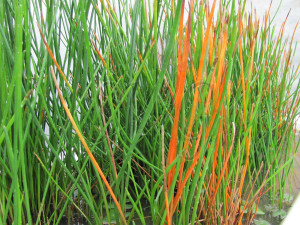
Water Chestnuts have a crispy nutty flavour. Commonly used in stir fries and salads. Water Chestnuts are harvested when the foliage dies down late Autumn. They can be easily grown in bath tubs, pots and I have also grown my water chestnuts in a small tub with just gravel and filled with water sitting on my window sill. Keep the large ones for eating and re plant the smaller chestnuts. For a bathtub size you only need approx. 15 to 20 small chestnuts. Fill the bath tub about 1/3 full with sandy loam or clay soil. Mix in some slow release fertiliser approx. 2 tablespoons and plant your corms. Then slowly fill the bath tub with water and watch them grow.
Limnophila aromatica Rice Paddy Herb
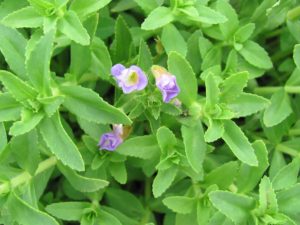
Rice Paddy herb has a citrusy – cumin taste and is used in Vietnamese dishes. It can be eaten raw or used in soups, curries, meat and fish dishes. I use it in my stir-fries all the time. Not only is this plant edible it also can be used as an Aquarium plant, once it is under water it takes a different form. You can grow this plant in a boggy area or I grow it in a pot sitting in water in full sun. If grown in a pond, the Rice paddy herb is a decorative plant that produces pretty blue almost like orchid flowers.
Oenanthe javonica Pink Flamingo
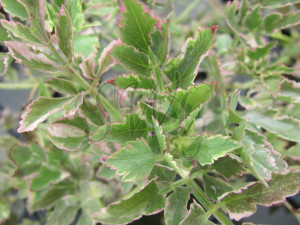
Oenanthe Javonica Pink Flamingo is also known as water celery because of the mild fragrance and taste of celery in the stems. Water celery is used in salads or as a garnish. The stems can also be cooked with rice. I mainly use it in my salads and for added taste and to add colour and interest to my salads. I grow mine in a pot in shallow water in part shade. The pink flamingo doesn’t do very well in the hot humid summer in Queensland, but come Autumn it loves it. By winter time the pink flamingo has a pink blush through its leaves which also makes it a lovely ornamental and decorative pond plant.
Nelumbo nucifera Lotus
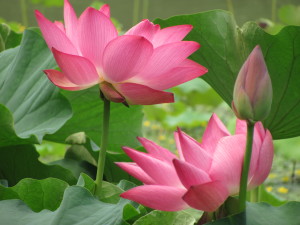
The Lotus would have to be one of my favourites. Just about all of the parts of the Lotus can be used. The seeds are eaten as a snack. Peel the outer casing of the seeds. The seeds have an embryo which is actually an already formed leaf ready and waiting too sprout. This inner leaf bud or embryo can be taken out or eaten with the seed but it does have a slightly bitter taste. The tubers can be sliced to reveal their beautiful pattern and used in stir fries, salads and other dishes. They can also be fried like chips. The leaves can be wrapped with meats or rice and herbs then steamed above boiling water. The stems can be soaked in hot water, dried and then fried in hot oil for a crispy snack. The flower petals can be used for garnish and the stamens for tea. And of course the Lotus pods. They certainly can add beauty to flower arrangements.
Pandanus Amaryliifolius Edible Pandan
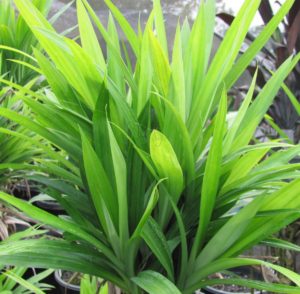
I just love Pandan. The pandan has been used in Asian countries for centuries, and used as a flavouring for rice and other dishes. I have mine planted in a pot and sitting in a tub of water under a shady tree and protected away from cold winds. Yes we do have cold winds here in South east QLD. It doesn’t like frosty winters and it can die back if it gets hit by frost. In the southern states, Pandan is best grown in a pot and placed in a hot house or even inside the home through winter and then moved to a protected area in the garden in summer. The leaves are picked and put into rice while its boiling. Pandan has also been used to make woven baskets. Wrapping the leaves around chicken with herbs creates a very tasty flavor through the chicken once it is cooked. There are so many other ways to use Pandan. No garden should be without it.
Ipomoea Aquatica Kang Kong Water Spinach
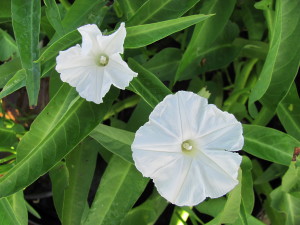
Kang Kong Water spinach is an Asian Spinach and has a very mild taste. I always use mine in salads or lightly cooked in stir fries. The stems can be sliced diagonally and added to stir fries then adding the leaves. I also lightly steam the stems and the leaves and use it as a side vegetable. Kang kong should be grown in a pot as it does have a tendency to escape. It will grow in boggy soils or in a tub of water and it will also grow on land. Shade or Full sun, therefore it must be KEPT CONTAINED.
Bacopa Monnieri Brahmi
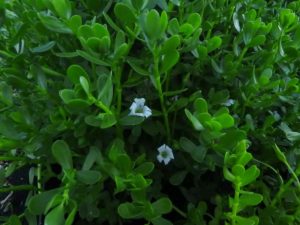
Bacopa Monnieri is known as the memory herb (Brahmi). The leaves and stems can be used in salads or as a herbal tea. I grow mine in a pot in shallow water but it can also grow submerged with leaves just showing out of the water. The small white flowers are decorative and a good nutrient soaker for the pond.
